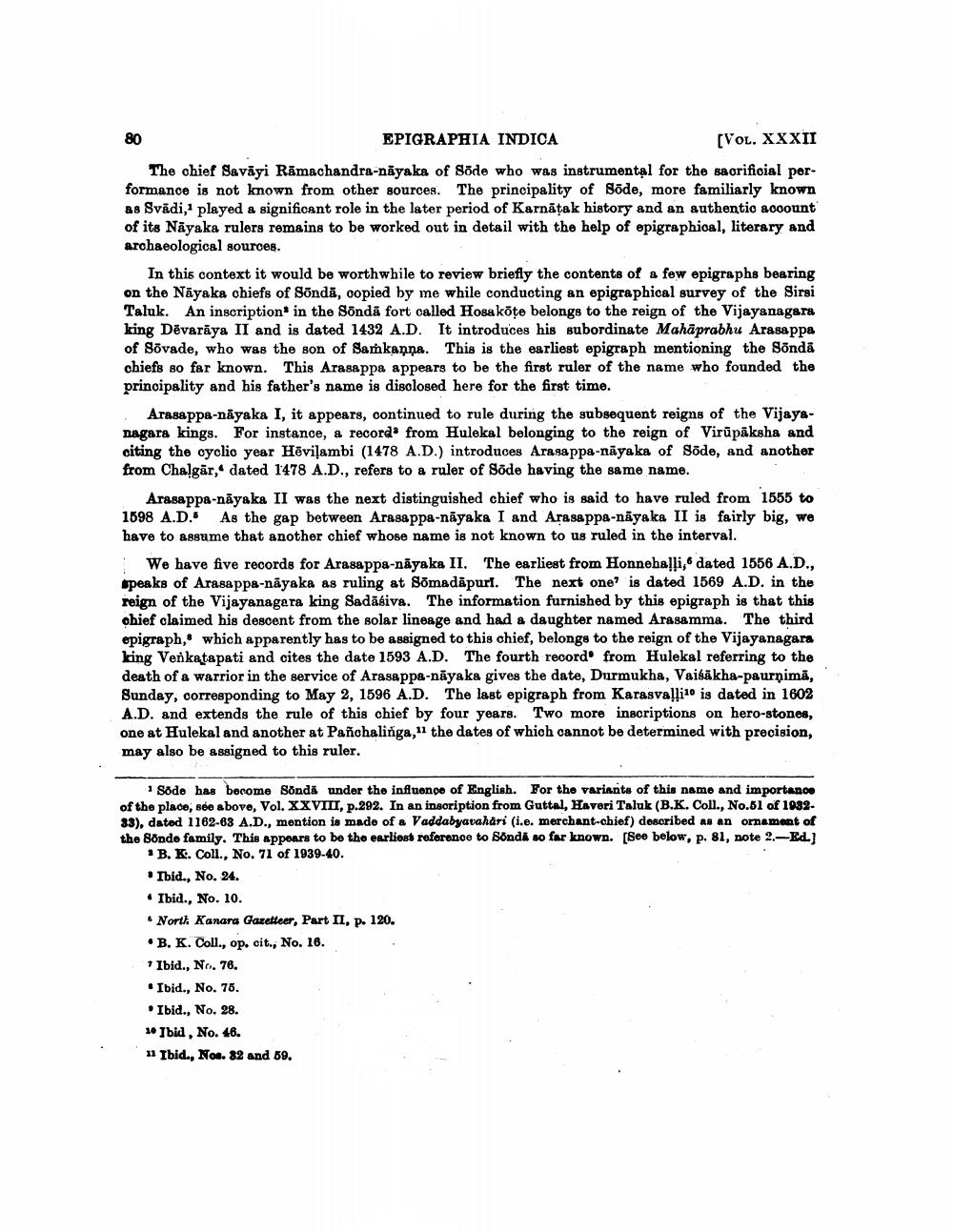________________
EPIGRAPHIA INDICA
[VOL. XXXII The chief Savayi Ramachandra-nayaka of Sōde who was instrumental for the sacrificial performance is not known from other sources. The principality of Sōde, more familiarly known as Svādi,1 played a significant role in the later period of Karnatak history and an authentic account of its Nayaka rulers remains to be worked out in detail with the help of epigraphical, literary and archaeological sources.
80
In this context it would be worthwhile to review briefly the contents of a few epigraphs bearing on the Nayaka chiefs of Sōndă, copied by me while conducting an epigraphical survey of the Sirsi Taluk. An inscription in the Sonda fort called Hosakote belongs to the reign of the Vijayanagara king Devaraya II and is dated 1432 A.D. It introduces his subordinate Mahaprabhu Arasappa of Sōvade, who was the son of Samkanna. This is the earliest epigraph mentioning the Sōnda chiefs so far known. This Arasappa appears to be the first ruler of the name who founded the principality and his father's name is disclosed here for the first time.
Arasappa-nayaka I, it appears, continued to rule during the subsequent reigns of the Vijayanagara kings. For instance, a record from Hulekal belonging to the reign of Virupaksha and citing the cyclic year Hevilambi (1478 A.D.) introduces Arasappa-nayaka of Sōde, and another from Chalgar, dated 1478 A.D., refers to a ruler of Sōde having the same name.
Arasappa-nayaka II was the next distinguished chief who is said to have ruled from 1555 to 1598 A.D. As the gap between Arasappa-nayaka I and Arasappa-nayaka II is fairly big, we have to assume that another chief whose name is not known to us ruled in the interval.
We have five records for Arasappa-nayaka II. The earliest from Honnehalli, dated 1556 A.D., speaks of Arasappa-nayaka as ruling at Sömadapurl. The next one is dated 1569 A.D. in the reign of the Vijayanagara king Sadasiva. The information furnished by this epigraph is that this chief claimed his descent from the solar lineage and had a daughter named Arasamma. The third epigraph, which apparently has to be assigned to this chief, belongs to the reign of the Vijayanagara king Venkatapati and cites the date 1593 A.D. The fourth record from Hulekal referring to the death of a warrior in the service of Arasappa-nayaka gives the date, Durmukha, Vaisakha-paurņimā, Sunday, corresponding to May 2, 1596 A.D. The last epigraph from Karasvalli10 is dated in 1602 A.D. and extends the rule of this chief by four years. Two more inscriptions on hero-stones, one at Hulekal and another at Pañchalinga," the dates of which cannot be determined with precision, may also be assigned to this ruler.
1 Sōde has become Sõnda under the influence of English. For the variants of this name and importance of the place, see above, Vol. XXVIII, p.292. In an inscription from Guttal, Haveri Taluk (B.K. Coll., No.51 of 193233), dated 1162-63 A.D., mention is made of a Vaddabyavahari (i.e. merchant-chief) described as an ornament of the Sonde family. This appears to be the earliest reference to Sonda so far known. [See below, p. 81, note 2.-Ed] B. K. Coll., No. 71 of 1939-40.
Ibid., No. 24.
Ibid., No. 10.
North Kanara Gazetteer, Part II, p. 120.
B. K. Coll., op. cit., No. 16.
7 Ibid., Nr. 76.
Ibid., No. 75.
⚫ Ibid., No. 28.
10 Ibid, No. 46.
11 Ibid., Nos. 32 and 59.




